Generally, a bistable multivibrator stays low until a trigger signal is applied and it stays high until a reset signal is applied. Bistable multi vibrators are also called as flip-flops or latches. The term flip-flop is used because it ‘flips’ to one state and stays there until a trigger is applied and once the trigger is applied it ‘flops’ back to the original state. Back to top
Bistable Multivibrator Circuit using 555 Timer
The circuit for a bistable multivibrator using the 555 timer is shown below
A bistable multivibrator is one of the easiest circuits that can be built using a 555 timer. It doesn’t require a capacitor as the RC charging unit is not responsible for the generation of the output. The generation of high and low outputs is not dependent on the charging and discharging of the capacitor in the RC unit but rather it is controlled by the external trigger and reset signals. The explanation of the bi stable mode of operation of the 555 timer is as follows. The trigger and reset pins (pins 2 and 4 respectively) are connected to the supply through two resistors R1 and R2 so that they are always high. In all the previous cases, the reset pin is not used and in order to avoid any accidental reset, it is simply connected to VCC. Two switches are connected between these pins and ground in order to make them go low momentarily. The switch at the trigger input will act as S (SET) input for the internal flip-flop. The switch at the reset input will act as reset for the internal flip-flop. When the switch S1 is pressed, the voltage from VCC will bypass the trigger terminal and is shorted to ground through the resistor R1. Hence, the trigger pulse will momentarily go low and the output of the timer at pin 3 will become HIGH. The output stays HIGH because there is no input from the threshold pin (pin 6 is left open or better if connected to ground) and the output of the internal comparator (comparator 1) will not go high. When the switch S2 is pressed, the voltage from VCC will bypass the reset terminal and is shorted to ground through the resistor R2. This pin is internally connected to the RESET terminal of the flip-flop. When this signal goes low for a moment, the flip-flop receives the reset signal and RESETs the flip-flop. Hence, the output will become LOW and stays there until the trigger is applied. The waveforms of the bistable mode of operation of the 555 timer are shown below.
Back to top
555 Timer Flip-flop and Memory Cell Circuit
Flip-flop
It is not a great choice to use a 555 timer as a flip-flop in computer applications. In typical computer applications, the clock pulse is used to drive the trigger and reset signals and the frequency of the clock signal is very high (generally in the order of Giga Hertz). The output of the 555 timer is not responsive enough to match the speed of the clock signals’ frequency. Readily available flip-flop devices are preferable when used in high speed operations. The 555 timer in bistable mode i.e. as a flip-flop can be used in low speed, non-computer applications like robotics. A simple application is a robot which moves forward and backward every time it hits an object. That being said, the circuit of a flip-flop using a 555 timer is shown below.
When the output at pin 3 is high, the capacitor C charges through the resistor R1 to the peak value i.e. VCC. When the output at pin 3 is low, the capacitor discharges through the same resistor to 0. In order to switch the output from high to low or low to high, a switch is used at the junction of trigger and threshold pins. The voltage divider formed by the resistors R2 and R3 will provide a voltage of VCC / 2 at the pins 6 and 2. When the switch is pressed, this voltage is interrupted and triggers the internal flip-flop. This will allow the output to switch between the two states. A circuit that acts as a toggle flip-flop is shown below. It is used to light an LED and the LED switches between ON and OFF when the switch is pressed.
Back to top
Memory Cell
Memory is an important unit in digital electronics. Flip-flops are the basic 1 – bit storage elements. A 555 timer, when used as a flip-flop, can act as a memory cell to store 1 – bit data. The circuit of a memory cell using 555 timer is shown below. It acts as an SR flip-flop.
The connection is similar to bistable mode of operation with a few extra components. When the set switch is pressed, the voltage at pin 2 goes low. This will SET the flip-flop and the output becomes HIGH which drives the LED connected to it. When the reset switch is pressed, the voltage at pin 4 goes low. This will RESET the flip-flop and the output becomes LOW which turns off the LED. Back to top Comment * Name * Email * Website
Δ



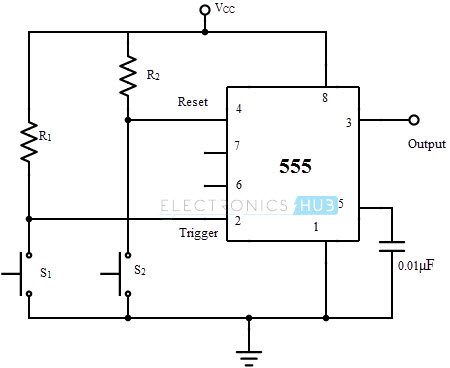
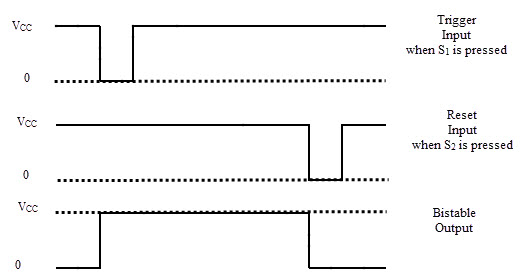
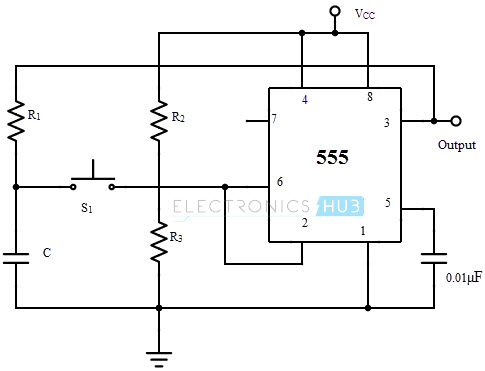
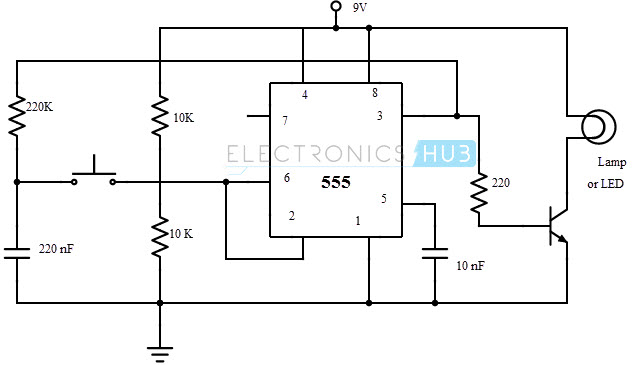
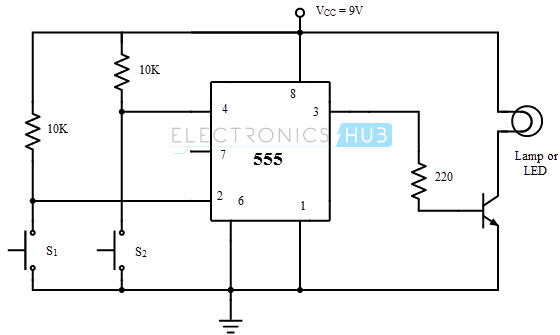


![]()